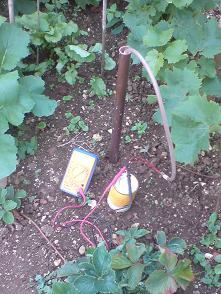This web page is periodically updated with data as it becomes available:
Brighton Webs - Soil Temperature
The photo shows the equipment in use, data logging is done with a pencil and paper.
The graph clearly shows the wide variations in temperature experienced by the topsoil. In winter radiative cooling on a clear night can take the topsoil temperature several degrees below the air temperature whilst a hot sunny day with a clear sky can raise it several degrees above it. The thermal environment of vegetables is much more turbulent than one would suppose from simply looking at the air temperature from a weather report. Some gardeners will have experienced the damage done by overnight frost and discovered this on a warm spring morning.
In contrast to the topsoil, the subsoil temperature closely follows the average air temperature. The relationship between the topsoil and subsoil temperatures is interesting, when the ground is cooling after the Summer Solstice, the subsoil is warmer than the topsoil. After the winter solstice, the subsoil takes a few weeks to start warming. It is as though the subsoil is acting like a storage heater, keeping the soil warm as Autumn and Winter approach. I was intrigued by this, the graph below shows a simulation of the solar irradiance received by the earth's surface and the average air temperature. Solar irradiance peaks at the Summer Solstice in June and is at a minimum at the Winter Solstice in December, yet the warmest month is July and the coldest one is January
Whilst solar insolation and radiative cooling account for a large part of the temperature variation experienced by the topsoil, advection is also significant. From January to April 2012, cold air masses moved across the Channel from Continental Europe, these acted to suppress the soil temperate, making it difficult for seeds to germinate, it was May before the topsoil temperature got above 10 deg. C.
Climate classification schemes as Koppen are based on the concept that native plants have adapted to the prevailing temperature and rainfall. In 1954 Dorothy Hartley published "Food in England", this was before the worldwide movement of fruit and vegetables. In the 1950s, market gardens could found on the edges of big town, also many people had been involved in part time vegetable cultivation during the war and had continued to do so in their back gardens. Some of the varieties described by Harley had been bought to England form overseas, the best known example being the potato which is thought to have originated some around Peru or Bolivia, but all of them had been grown here for at least a hundred years. A common characteristic of most of the plants grown from seed is that they will germinate in temperatures of less than 10 deg. C..






No comments:
Post a Comment